Combigan Ophthalmic Solution 5 ml
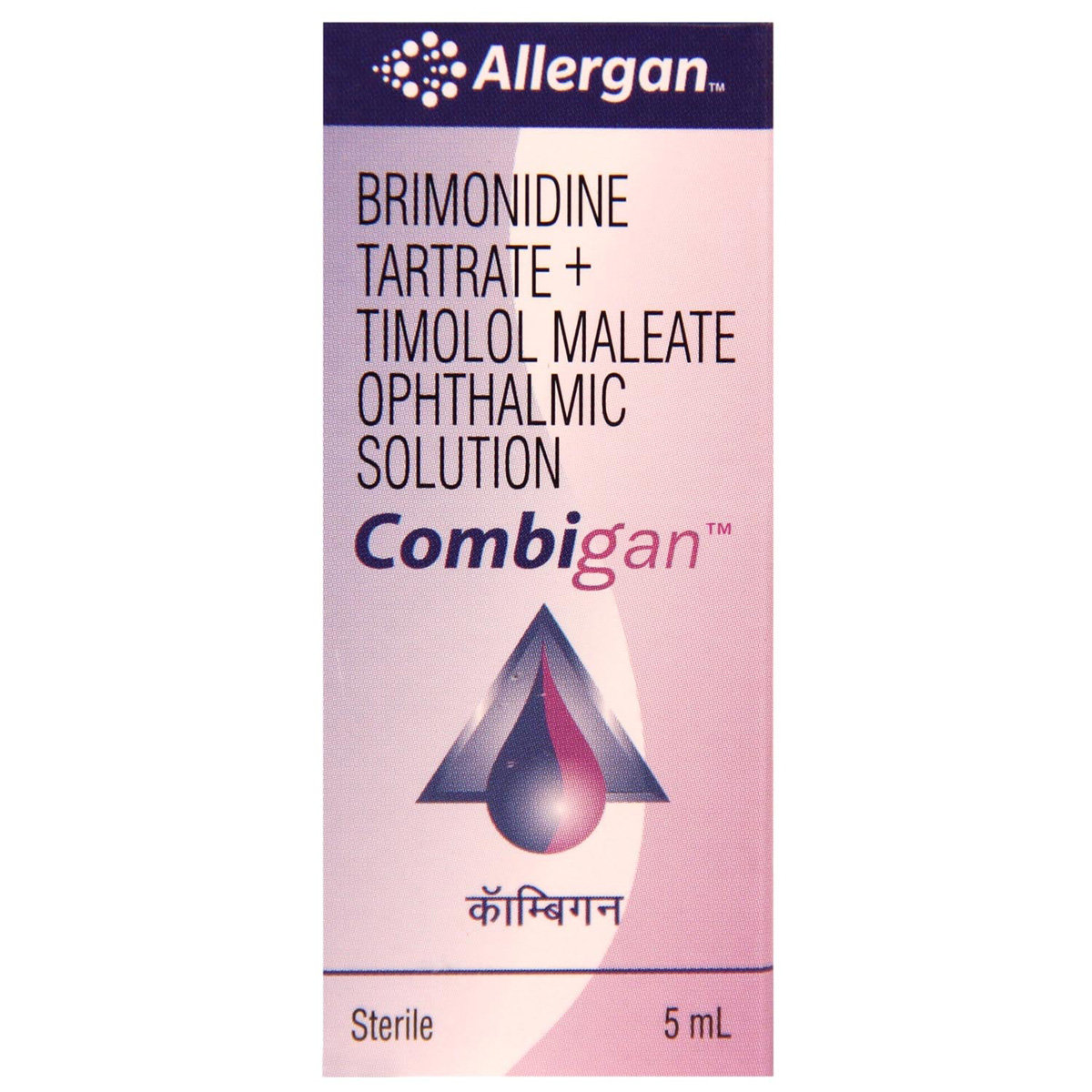





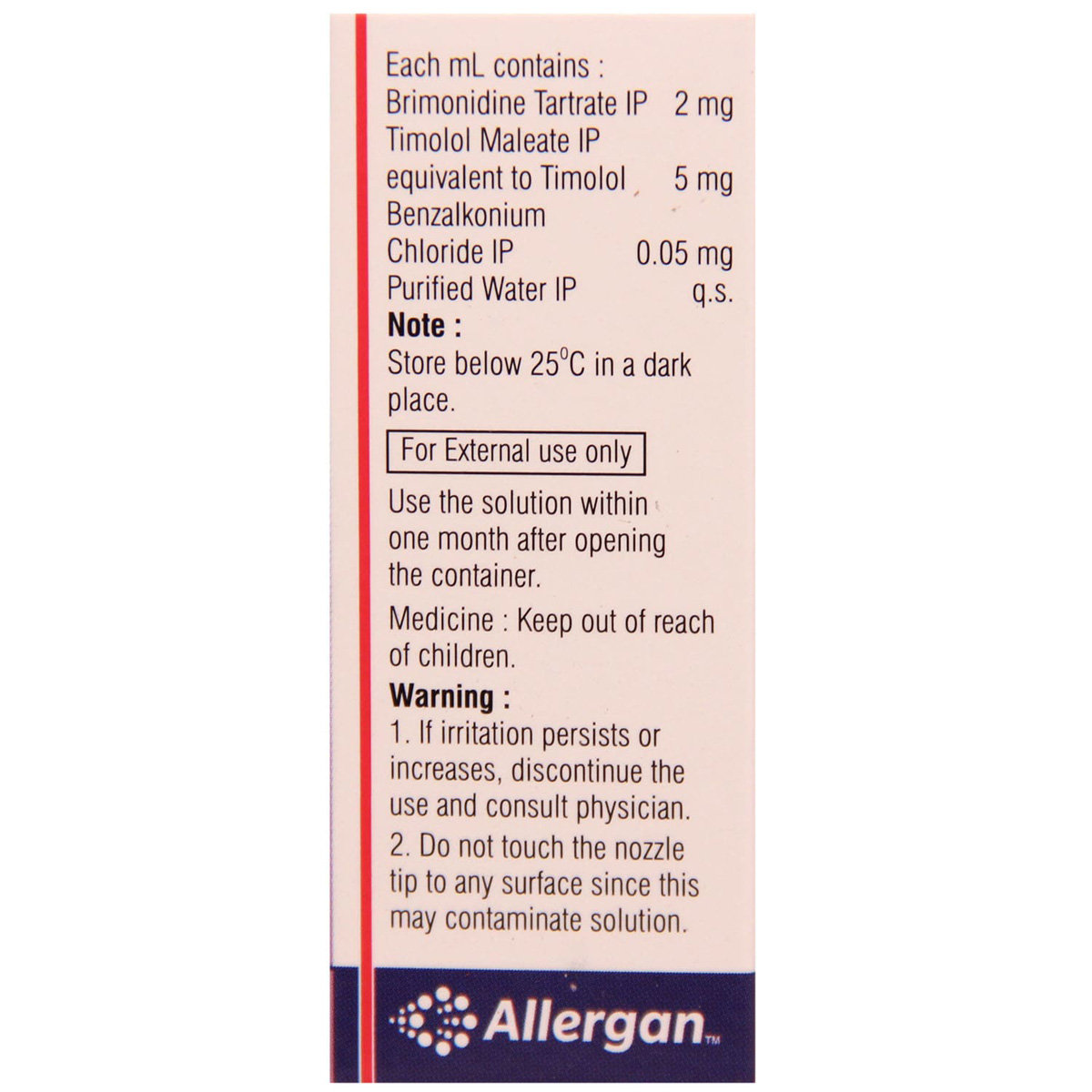
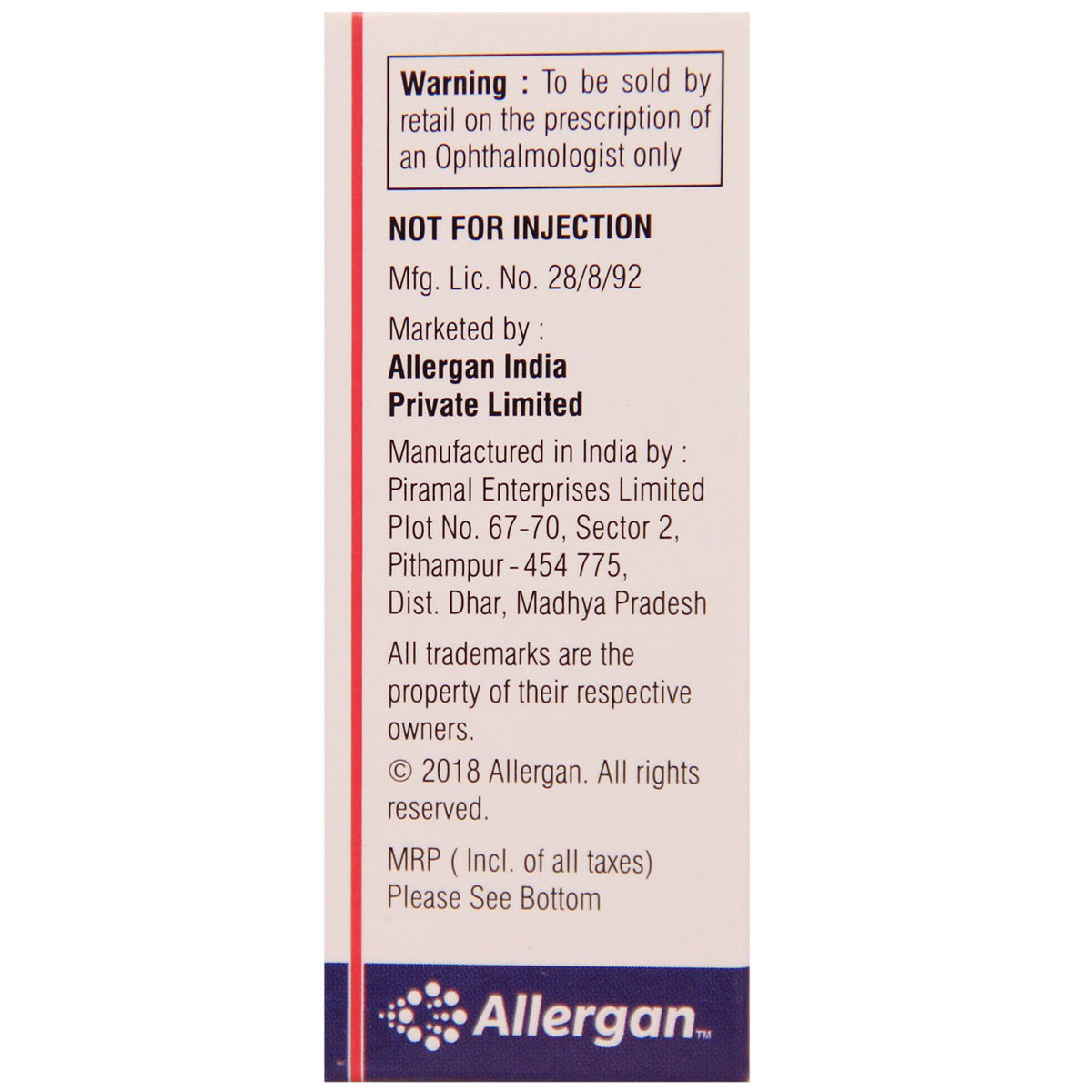
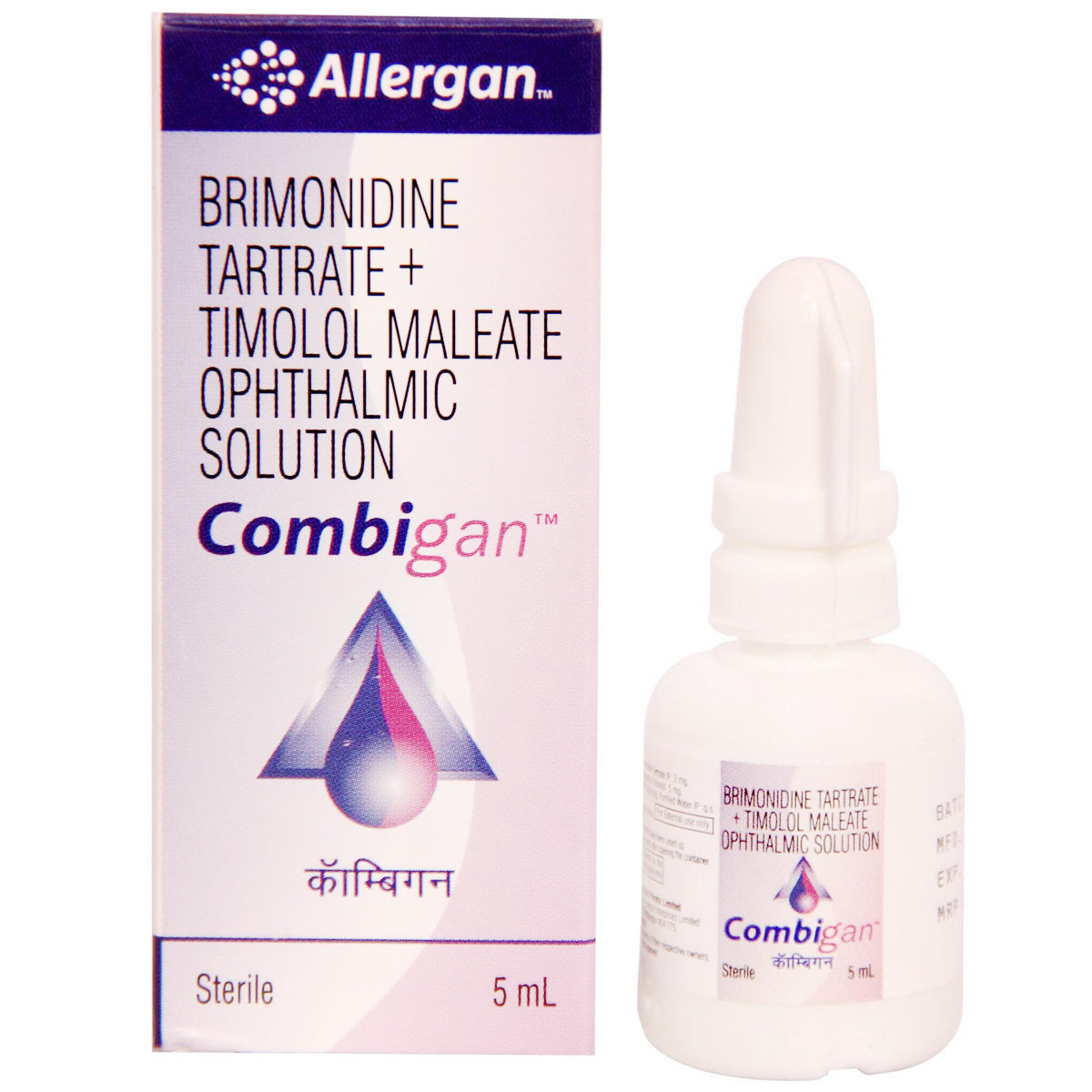
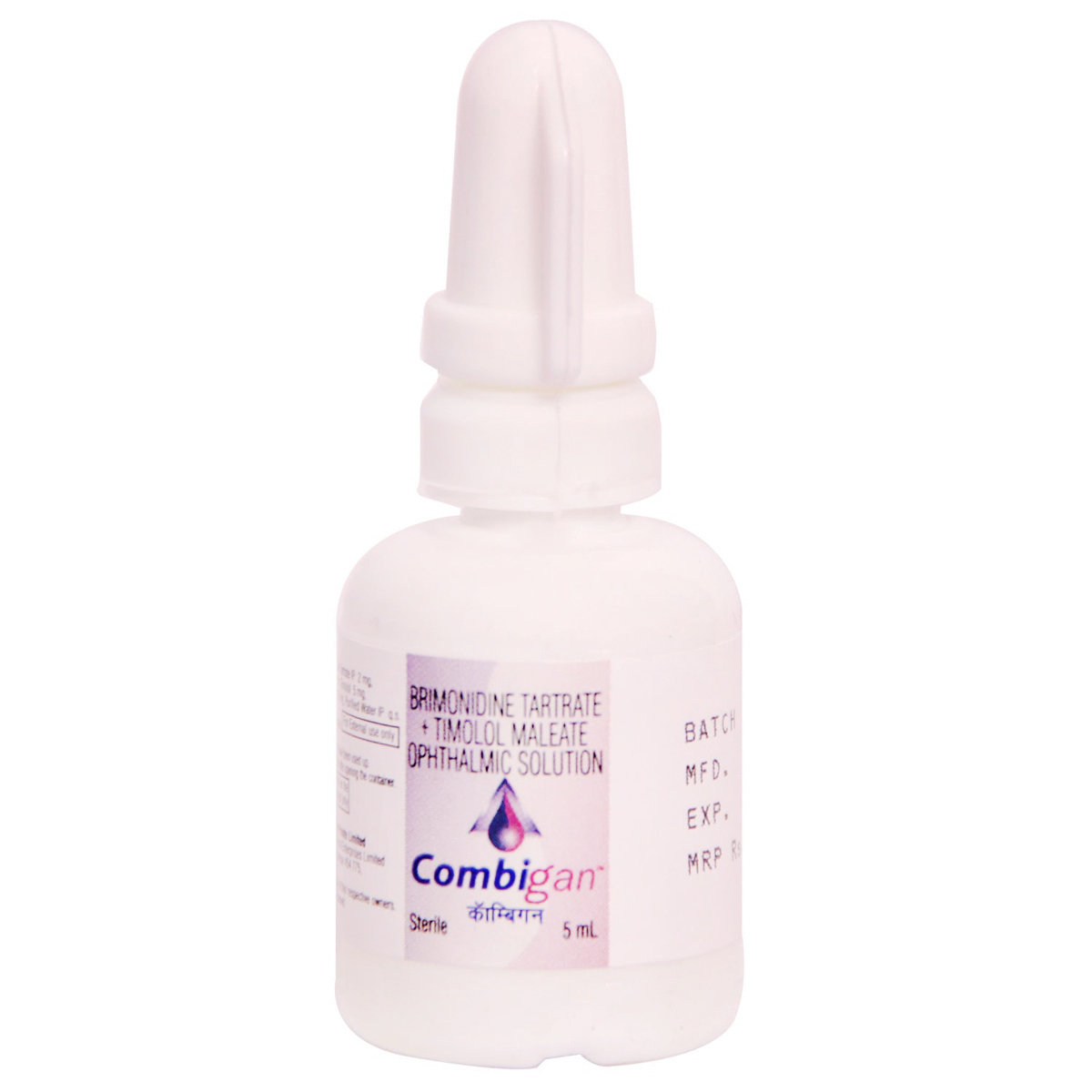
MRP ₹502
(Inclusive of all Taxes)
₹75.3 Cashback (15%)
Provide Delivery Location
Online payment accepted
 Prescription drug
Prescription drugWhats That
Manufacturer/Marketer :
Consume Type :
Expires on or after :
Return Policy :
About Combigan Ophthalmic Solution 5 ml
Combigan Ophthalmic Solution 5 ml is a combination medicine indicated for lowering elevated intraocular pressure in patients with glaucoma or ocular hypertension. Glaucoma is an eye disease that causes damage to the optic nerve and results in reduced vision. Ocular hypertension is increased pressure in the eye due to poor drainage of aqueous humour (fluid in the eye that maintains normal pressure by its continuous flow).
Combigan Ophthalmic Solution 5 ml contains Brimonidine tartrate (alpha-2 adrenergic receptor agonists), Timolol (beta-blocker), and Benzalkonium chloride (preservative). Brimonidine tartrate and timolol decrease the production of aqueous humour and increase the amount of fluid that is drained. Benzalkonium chloride acts as a preservative. Together, Combigan Ophthalmic Solution 5 ml helps lower the increased pressure in the eye.
You are advised to use Combigan Ophthalmic Solution 5 ml for as long as your doctor has prescribed it for you, depending on your medical condition. In some cases, you may experience common side effects such as burning sensation, eye redness, itching, irritation, and vision disturbances. Most of these side effects do not require medical attention and will resolve gradually over time. However, you are advised to talk to your doctor if the side effects persist or worsen.
Consult a doctor if you are pregnant or breastfeeding. Combigan Ophthalmic Solution 5 ml is not recommended for children below 17 years as safety and effectiveness have not been established. Combigan Ophthalmic Solution 5 ml might cause drowsiness; so, drive only if you are alert. Avoid touching the tip of the dropper as it may contaminate the contents. Keep your doctor informed about your health condition and the medicines you are taking to prevent any side effects/interactions.
Uses of Combigan Ophthalmic Solution 5 ml
Directions for Use
Key Benefits
Combigan Ophthalmic Solution 5 ml is a combination of three drugs, namely: Brimonidine tartrate, Timolol, and Benzalkonium chloride. Combigan Ophthalmic Solution 5 ml is indicated for lowering intraocular pressure in patients with glaucoma or ocular hypertension. Brimonidine tartrate belongs to a group of medicines called alpha-2 adrenergic receptor agonists, and Timolol belongs to a group of medicines called beta-blockers. They work by decreasing the production of aqueous humour and increasing the amount of liquid that is drained. Benzalkonium chloride acts as a preservative. Together, Combigan Ophthalmic Solution 5 ml helps lower the increased pressure in the eye.
Storage
Drug Warnings
Do not use Combigan Ophthalmic Solution 5 ml if you are allergic to any of its contents, if you have/had bronchial asthma, severe chronic obstructive bronchitis, low heart rate, heartbeat disorder, heart failure, if you are taking anti-depressants or monoamine oxidase inhibitors. Inform your doctor if you have/had coronary heart disease, slow heartbeat, breathing problems, chronic obstructive pulmonary disease, poor blood circulation disease, diabetes, overactive thyroid, tumour of the adrenal gland, corneal disease, excess acidity in the blood, kidney or liver problems. If you are due to have any surgery or eye surgery, inform the doctor/surgeon that you are taking Combigan Ophthalmic Solution 5 ml. Consult a doctor if you are pregnant or breastfeeding. Combigan Ophthalmic Solution 5 ml is not recommended for children below 17 years. Combigan Ophthalmic Solution 5 ml might cause drowsiness, blurred vision; so, drive only if you are alert.
Drug-Drug Interactions
Drug-Drug Interactions
Login/Sign Up
Co-administration of Clonidine and Combigan Ophthalmic Solution 5 ml together may lower the blood pressure.
How to manage the interaction:
Although there is a possible interaction between Clonidine and Combigan Ophthalmic Solution 5 ml, you can take these medicines together if prescribed by your doctor. However, if you experience headaches, slow heartbeat, dizziness, or feeling like you might pass out, contact a doctor. Do not discontinue any medications without consulting a doctor.
Co-administration of atazanavir with Combigan Ophthalmic Solution 5 ml can increase the risk of irregular heart rhythm.
How to manage the interaction:
Although taking atazanavir and Combigan Ophthalmic Solution 5 ml together can possibly result in an interaction, it can be taken if your doctor has advised it. However, if you experience symptoms such as sudden dizziness, lightheadedness, fainting, or irregular heartbeat consult a doctor immediately. Do not discontinue any medications without consulting a doctor.
Co-administration of Salmeterol with Combigan Ophthalmic Solution 5 ml can decrease the action of both the medications, can increase the risk or severity of side effects including increased risk of asthma, breathing problems.
How to manage the interaction:
Although taking salmeterol and Combigan Ophthalmic Solution 5 ml together can possibly result in an interaction, it can be taken if your doctor has advised it. However, if you experience any unusual symptoms consult a doctor immediately. Do not discontinue any medications without consulting a doctor.
Co-administration of Pirbuterol with Combigan Ophthalmic Solution 5 ml can decrease the action of both the medications, can increase the risk or severity of side effects including increased risk of asthma, breathing problems.
How to manage the interaction:
Although taking pirbuterol and Combigan Ophthalmic Solution 5 ml together can possibly result in an interaction, it can be taken if your doctor has advised it. However, if you experience any unusual symptoms consult a doctor immediately. Do not discontinue any medications without consulting a doctor.
Co-administration of ceritinib with Combigan Ophthalmic Solution 5 ml can increase the risk of irregular heart rhythm.
How to manage the interaction:
Although taking certinib and Combigan Ophthalmic Solution 5 ml together can possibly result in an interaction, it can be taken if your doctor has advised it. However, if you experience symptoms such as dizziness, lightheadedness, fainting, or irregular heartbeat, consult a doctor immediately. Do not discontinue any medications without consulting a doctor.
Co-administration of salbutamol with Combigan Ophthalmic Solution 5 ml can increase the risk of narrowing of the airways.
How to manage the interaction:
Although taking salbutamol and Combigan Ophthalmic Solution 5 ml together can possibly result in an interaction, it can be taken if your doctor has advised it. However, if you experience Coughing, wheezing, shortness of breath, and high-pitched breathing, contact your doctor immediately. Do not discontinue any medications without consulting a doctor.
Taking Combigan Ophthalmic Solution 5 ml with formoterol could reduce the benefits of both medications because they have opposite effects on the body.
How to manage the interaction:
Although taking formoterol and Combigan Ophthalmic Solution 5 ml together can possibly result in an interaction, it can be taken if your doctor has advised it. However, if you experience any unusual symptoms, contact your doctor immediately. Do not stop using any medications without talking to your doctor.
Co-administration of Olodaterol with Combigan Ophthalmic Solution 5 ml can decrease the action of both the medications, can increase the risk or severity of side effects including increased risk of asthma, breathing problems.
How to manage the interaction:
Although taking olodaterol and Combigan Ophthalmic Solution 5 ml together can possibly result in an interaction, it can be taken if your doctor has advised it. Do not discontinue any medications without consulting a doctor.
Co-administration of diltiazem with Combigan Ophthalmic Solution 5 ml can increase the risk or severity of side effects.
How to manage the interaction:
Taking diltiazem with Combigan Ophthalmic Solution 5 ml can lead to an interaction, however, it can be taken only if your doctor has advised it. If you experience symptoms such as fatigue, headache, fainting, swelling of the hands and legs, chest pain, increased or decreased heartbeat, or irregular heartbeats, or difficulty in breathing, contact a doctor immediately. Do not discontinue any medications without consulting a doctor.
Co-administration of verapamil with Combigan Ophthalmic Solution 5 ml can increase the risk or severity of side effects.
How to manage the interaction:
Although taking verapamil and Combigan Ophthalmic Solution 5 ml together can result in an interaction, it can be taken if a doctor has advised it. However, if you experience symptoms such as fatigue, headache, fainting, swelling of the extremities, weight gain, shortness of breath, chest pain, increased or decreased heartbeat, or irregular heartbeat consult a doctor immediately. Do not discontinue any medications without consulting a doctor.
Drug-Food Interactions
Drug-Food Interactions
Login/Sign Up
Diet & Lifestyle Advise
- Include fresh fruits and vegetables in your diet.
- Avoid smoking and alcohol consumption.
- Avoid intake of baked foods such as cakes, cookies, doughnuts or fried items such as french fries and stick margarine as these foods may worsen glaucoma and damage the optic nerve.
- Cut down your coffee intake as it may increase pressure in the eye. Replace coffee with green tea.
- Avoid exercises such as any position where the head is lower than the body, like an inverted yoga pose, as it may increase pressure in the eye. Doing selective exercises is advised for glaucoma patients.
Side Effects of Combigan Ophthalmic Solution 5 ml
- Burning sensation
- Eye redness
- Eye itching
- Irritation
- Vision disturbances
Habit Forming
Therapeutic Class
All Substitutes & Brand Comparisons
Author Details
We provide you with authentic, trustworthy and relevant information
Drug-Diseases Interactions
Drug-Diseases Interactions
Login/Sign Up
FAQs
Combigan Ophthalmic Solution 5 ml contains Brimonidine tartrate, Timolol, and Benzalkonium chloride. Brimonidine tartrate and timolol decrease the production of aqueous humour and increase the amount of fluid that is drained. Benzalkonium chloride acts as a preservative. Together, Combigan Ophthalmic Solution 5 ml helps lower the increased pressure in the eye.
Do not stop using Combigan Ophthalmic Solution 5 ml without consulting your doctor. Continue using Combigan Ophthalmic Solution 5 ml for as long as your doctor has prescribed it to you to treat your condition effectually. Consult the doctor if you experience any difficulty while using Combigan Ophthalmic Solution 5 ml.
Combigan Ophthalmic Solution 5 ml might cause blurred vision and vision disturbances. So, avoid driving or operating machinery until your vision is clear to prevent any mishappening.
Combigan Ophthalmic Solution 5 ml contains benzalkonium chloride; it might discolour soft contact lenses. Therefore, do not wear contact lens while using Combigan Ophthalmic Solution 5 ml. Remove contact lenses before using Combigan Ophthalmic Solution 5 ml and put them back 15 minutes after using Combigan Ophthalmic Solution 5 ml.
Consult your doctor before using Combigan Ophthalmic Solution 5 ml if you have hypertension. Regularly monitor blood pressure levels while taking Combigan Ophthalmic Solution 5 ml to prevent unpleasant events.
Dry mouth could be a side-effect of Combigan Ophthalmic Solution 5 ml. Limiting caffeine intake, avoiding smoking and mouthwashes containing alcohol, drinking water regularly, and chewing sugar-free gum/candy might stimulate saliva and prevent drying of the mouth.
Combigan Ophthalmic Solution 5 ml can be used with other eye medications if prescribed by the doctor. However, maintain a gap of 5-10minutes between Combigan Ophthalmic Solution 5 ml and other eye medications.
Consult your doctor before using Combigan Ophthalmic Solution 5 ml if you are diabetic as Combigan Ophthalmic Solution 5 ml contains timolol; it might lower the blood glucose levels and may mask the symptoms of low blood sugar levels. Regular monitoring of blood glucose levels whilst taking Combigan Ophthalmic Solution 5 ml is advised.
Disease/Condition Glossary
Glaucoma: It is an eye condition that causes damage to the optic nerve (essential for good vision) due to abnormally increased pressure in the eye. If it is not treated in time, it may cause blindness. Usually, there are no symptoms for glaucoma initially, except the slow loss of vision gradually. However, some symptoms include visible rainbow-coloured circles around bright lights or blurred vision. Rarely, glaucoma can develop suddenly with intense pain in the eye, visual disturbance or nausea.
Ocular hypertension: It is a condition caused due to poor drainage of aqueous humour (fluid in the eye that maintains normal pressure by its continuous flow). This leads to a build-up of excess fluid in the eye resulting in increased pressure inside the eye. If ocular hypertension is not controlled, it may lead to glaucoma.

Have a query?
Buy best Ocular products by
Entod Pharmaceuticals Ltd
Ajanta Pharma Ltd
Sunways (India) Pvt Ltd
Sun Pharmaceutical Industries Ltd
Cipla Ltd
Micro Labs Ltd
Allergan Healthcare India Pvt Ltd
Intas Pharmaceuticals Ltd
Raymed Pharmaceuticals Ltd
Nri Vision Care India Ltd
FDC Ltd
Jawa Pharmaceuticals India Pvt Ltd
Indoco Remedies Ltd
Sapient Laboratories Pvt Ltd
Senses Pharmaceuticals Pvt Ltd
Centaur Pharmaceuticals Pvt Ltd
Neomedix Healthcare India Pvt Ltd
Aromed Pharmaceuticals
Optho Remedies Pvt Ltd
Aurolab
Austrak Pvt Ltd
Lupin Ltd
Mankind Pharma Pvt Ltd
Zivira Labs Pvt Ltd
Optho Pharma Pvt Ltd
Synovia Life Sciences Pvt Ltd
Akumentis Healthcare Ltd
Eyekare
His Eyeness Ophthalmics Pvt Ltd
Protech Remedies Pvt Ltd
Runyon Pharmaceutical Pvt Ltd
Alcon Laboratories Inc
Syntho Pharmaceuticals Pvt Ltd
Alembic Pharmaceuticals Ltd
Bell Pharma Pvt Ltd
Klar Sehen Pvt Ltd
Sentiss Pharma Pvt Ltd
Irx Pharmaceuticals Pvt Ltd
Optho Life Sciences Pvt Ltd
Phoenix Remedies Pvt Ltd
Alkem Laboratories Ltd
Doctor Wonder Pvt Ltd
Hicare Pharma
Ipca Laboratories Ltd
Neon Laboratories Ltd
Okulus Drugs India
Pharmtak Ophthalmics (I) Pvt Ltd
Berry & Herbs Pharma Pvt Ltd
Glow Vision Pharmaceuticals
Kaizen Drugs Pvt Ltd
Choroid Laboratories Pvt Ltd
Indiana Opthalamics Pvt Ltd
Optica Pharmaceutical Pvt Ltd
Pharmatak Opthalmics India Pvt Ltd
Samarth Life Sciences Pvt Ltd
Vibgyor Vision Care
Mofon Drugs
Novartis India Ltd
Pharmia Biogenesis Pvt Ltd
Zydus Cadila
Appasamy Ocular Devices Pvt Ltd
Leeford Healthcare Ltd
Medivision Pharma Pvt Ltd
Orbit Life Science Pvt Ltd
X-Med Royal Pharma Pvt Ltd
Zee Laboratories Ltd
Aarma Laboratories
Guerison MS Inc
Laborate Pharmaceuticals India Ltd
Xtas Pharmaceuticals
Accurex Biomedical Pvt Ltd
Blucrab Pharma Pvt Ltd
Does Health Systems Pvt Ltd
Flagship Biotech International Pvt Ltd
Lavue Pharmaceuticals Pvt Ltd
Nutrilis Healthcare Pvt Ltd
Ursa Pharm India Pvt Ltd
Vee Remedies
Vyonics Health Care India Pvt Ltd
Warren Pharmaceuticals Pvt Ltd
Abbott India Ltd
Accvus Pharmaceuticals
Akums Drugs & Pharmaceuticals Ltd
Cadila Healthcare Ltd
Carevision Pharmaceuticals Pvt Ltd
Dey's Medical Stores (Mfg) Ltd
East West Pharma India Pvt Ltd
Eyedea Pharmaceuticals Pvt Ltd
Nimbus Healthcare Pvt Ltd
Ocuris Pharmaceuticals Pvt Ltd
Sherings Pharmaceuticals
Tarks Pharmaceuticals Pvt Ltd
Vcan Biotech
Vision Medilink
Aice Health Care Pvt Ltd
Appasamy Pharmaceuticals Pvt Ltd
Asperia Lifescience Pvt Ltd
Beatum Healthcare Pvt Ltd
East India Pharmaceutical Works Ltd
Grevis Pharmaceutical Pvt Ltd
Alcohol
Safe if prescribed
It is not known if alcohol interacts with Combigan Ophthalmic Solution 5 ml. Please consult your doctor if you have any concerns.
Pregnancy
Consult your doctor
Please consult your doctor if you have any concerns regarding this; your doctor will prescribe only if the benefits outweigh the risks.
Breast Feeding
Consult your doctor
Consult your doctor if you are breastfeeding. Your doctor will decide if Combigan Ophthalmic Solution 5 ml can be used by breastfeeding mothers or not.
Driving
Safe if prescribed
Combigan Ophthalmic Solution 5 ml might cause tiredness, drowsiness, and blurred/abnormal vision. So, avoid driving or operating machinery until your vision is clear.
Liver
Consult your doctor
Please consult your doctor if you have any concerns regarding the usage of Combigan Ophthalmic Solution 5 ml in patients with liver impairment.
Kidney
Consult your doctor
Please consult your doctor if you have any concerns regarding the usage of Combigan Ophthalmic Solution 5 ml in patients with kidney impairment.
Children
Safe if prescribed
Combigan Ophthalmic Solution 5 ml is not recommended for children below 17 years as safety and effectiveness have not been established.



_0.jpg?tr=q-85)

